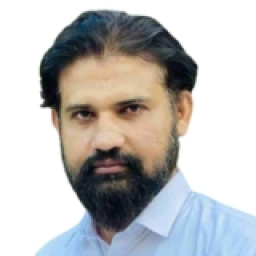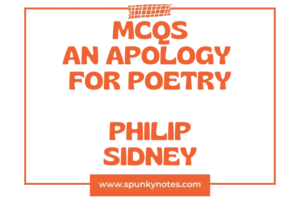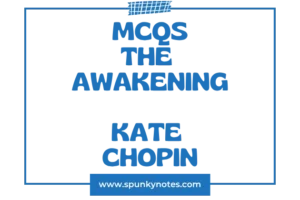

Estimated Reading Time: 17 min
A Portrait of the Artist as a Young Man MCQs
1. Who first told Stephen the story of the moocow?
A. Uncle Charles
B. Dante
C. His father
D. Betty Byrne
2. What colors were associated with the political brushes kept by Dante?
A. Yellow and blue
B. Maroon and green
C. Red and white
D. Black and gold
3. What did Dante threaten Stephen with if he did not apologize?
A. Going to hell
B. The eagles will pull out his eyes
C. His father beating him
D. Being expelled
4. What item did Dante give Stephen when he brought her tissue paper?
A. A shilling
B. A lemon platt
C. A cachou
D. A ribbon
5. What name did Nasty Roche give to the Friday pudding at Clongowes?
A. Shortbread
B. Hogwash
C. Lemon Platt
D. Dog-in-the-blanket
6. Why did Wells push Stephen into the square ditch?
A. Stephen insulted him
B. Stephen would not trade his snuff box
C. Stephen preached on him
D. Stephen was laughing
7. Which kind of creature had a fellow seen jump into the scum of the square ditch?
A. A frog
B. A rat
C. A snake
D. A dog
8. In the geography book, what color did Fleming use to color the earth?
A. Maroon
B. Red
C. Green
D. Blue
9. Which Jesuit motto was found pointing to the words AD MAJOREM DEI GLORIAM on a picture?
A. Saint Aloysius
B. Saint Francis Xavier
C. Saint Ignatius Loyola
D. Lorenzo Ricci
10. What politician’s death was the center of the fierce Christmas dinner argument?
A. Michael Davitt
B. Lord Leitrim
C. Charles Stewart Parnell
D. Henry Grattan
11. Which characters were on Parnell’s side during the Christmas argument?
A. Dante and Mrs. Dedalus
B. Mr. Dedalus and Mr. Casey
C. Uncle Charles and Stephen
D. Dante and Uncle Charles
12. What did Dante scream after Mr. Casey shouted, “No God for Ireland!”?
A. Traitor!
B. Devil out of hell!
C. Sons of bitches!
D. Blasphemer!
13. What was Stephen thinking about when the prefect of studies (Father Dolan) pandied him?
A. His broken glasses
B. The Latin sum
C. His mother is crying
D. Being wrongly punished
14. How did the boys react when Stephen returned from seeing the Rector about the pandying?
A. They ignored him
B. They cheered the Rector and groaned for Father Dolan
C. They asked him to leave the college
D. They began to fight
15. What type of tobacco did Uncle Charles usually smoke in the outhouse?
A. Cigars
B. Pipes
C. Black twist
D. Cigarettes
16. What book did Stephen pore over every evening during his time in Blackrock?
A. Doctor Cornwell’s Spelling Book
B. Richmal Magnall’s Questions
C. The Count of Monte Cristo
D. Peter Parley’s Tales
17. Why was Stephen not sent back to Clongowes after the holiday?
A. He was sick
B. He was expelled
C. His father was having money troubles
D. He refused to go back
18. What disturbing word did Stephen see carved into a desk in the anatomy theatre in Cork?
A. JESUS
B. FOETUS
C. ANATOMY
D. DIEU
19. When wandering in Cork, what poet’s lines did Stephen repeat that emphasized human ineffectiveness?
A. Ben Jonson
B. Lord Byron
C. Lord Tennyson
D. Shelley
20. What did Stephen try to cover up at Newcombe’s coffee-house regarding his father?
A. His father’s financial trouble
B. His father’s drinking bout
C. His father’s accent
D. His father’s flirting
21. What biblical book was the retreat theme, “REMEMBER ONLY THY LAST THINGS,” taken from?
A. Psalms
B. Ecclesiastes
C. Isaias
D. New Testament
22. What were the four last things discussed during the religious retreat?
A. Faith, hope, charity, sin
B. Pride, lust, anger, sloth
C. Death, judgment, hell, heaven
D. Joy, sorrow, glory, peace
23. According to the sermon, what sin caused Lucifer’s fall from heaven?
A. Envy
B. Lust
C. Pride
D. Greed
24. According to the sermon, why did God create Adam and Eve?
A. To worship Him
B. To populate the earth
C. To fill the seats left vacant by fallen angels
D. To be His companions
25. What is the greatest spiritual torment in hell, according to the second sermon?
A. Pain of fire
B. Pain of conscience
C. Pain of loss
D. Pain of extension
26. What horrible sensory torment increases the agony of the fire in hell, which gives forth no light?
A. Terrible sounds
B. Darkness
C. Coldness
D. Thirst
27. What creature did Stephen imagine inhabiting his own hell during the retreat?
A. Fiery demons
B. Goatish creatures
C. Giant rats
D. Snakes
28. What kind of priest heard Stephen’s first detailed confession?
A. A Jesuit
B. A Dominican
C. A Capuchin
D. A Franciscan
29. To whom did the priest recommend Stephen pray for help against sins of impurity?
A. Saint Francis Xavier
B. God the Father
C. Our mother Mary
D. Saint Joseph
30. What did Stephen note was set on the kitchen dresser the morning after his confession, symbolizing his peaceful new life?
A. Holy books
B. White flowers
C. Sausages and white pudding
D. A statue of Mary
31. Which day of the week did Stephen dedicate to the Most Blessed Sacrament of the Altar?
A. Sunday
B. Tuesday
C. Thursday
D. Saturday
32. What three theological virtues did Stephen pray to strengthen via his daily rosaries?
A. Purity, humility, obedience
B. Faith, hope, charity
C. Truth, beauty, goodness
D. Wisdom, knowledge, understanding
33. What did Stephen attempt to mortify by allowing air to sting a part of his undried body?
A. Taste
B. Sight
C. Touch
D. Smell
34. When Stephen refused the vocation, he realized that what was winning the day in his soul?
A. The disorder in his father’s house
B. The Catholic Church
C. His pride
D. The Jesuit Order
35. What did the Director of Studies tell Stephen about the power of a priest?
A. He is humble
B. He has the power of the keys
C. He is patient
D. He is a shepherd
36. What kind of bird did Stephen compare the girl on the strand to during his epiphany?
A. Eagle
B. Dove
C. Seabird
D. Swallow
37. What local Irish word did Stephen correct the Dean of Studies for calling a funnel?
A. Soutane
B. Tundish
C. Les jupes
D. Funnel
38. What classical philosopher’s words did Stephen use to define beauty?
A. Plato
B. Aristotle
C. Epictetus
D. Aquinas
39. What does Stephen believe is the first step in the direction of beauty?
A. To find the truth
B. To understand the intellect
C. To understand the imagination
D. To embrace sin
40. What, according to Stephen, is the kinetic emotion excited by improper art?
A. Pity or Terror
B. Desire or loathing
C. Wholeness or harmony
D. Clarity or stasis
41. What are the three qualities of beauty required by Aquinas, as translated by Stephen?
A. Truth, virtue, emotion
B. Lyrical, epic, dramatic
C. Wholeness, harmony, radiance
D. Faith, hope, charity
42. What is the final, ultimate form of art in Stephen’s theory?
A. Lyrical
B. Epical
C. Dramatic
D. Poetic
43. What phrase about Ireland did Stephen bitterly use to express his alienation?
A. A priest-ridden race
B. The old sow that eats her farrow
C. The beautiful Mabel Hunter
D. An unfortunate land
44. What were the three “arms” Stephen resolves to use for his own defense and flight?
A. Poetry, thought, logic
B. Faith, hope, cunning
C. Silence, exile, cunning
D. Study, work, prayer
45. Which friend’s face was compared to a “hooded reptile” with a long, slender, flattened skull?
A. Cranly
B. MacCann
C. Davin
D. Lynch
46. Who did Stephen imagine sitting at the old piano and listening to his songs at the carnival ball?
A. Eileen
B. The próstitute
C. Emma
D. His sister
47. What does Stephen fear more than the God of the Roman Catholics striking him dead?
A. His mother’s suffering
B. Cranly’s judgment
C. Chemical action of false homage
D. Dogs and horses
48. Who was Cranly thinking of when Stephen asked him who he loved more than a friend?
A. Himself
B. God
C. Stephen
D. A woman
49. What kind of birds did Stephen observe wheeling and crying, seeking an augury on the library steps?
A. Crows
B. Swallows
C. Gulls
D. Pigeons
50. What words does Stephen repeat in his mind that represent the eternal, recurring suffering of his family and race?
A. The rhythm of the villanelle
B. Broken lines of Virgil
C. The Jesuit motto
D. The words of Aquinas
Brief Overview
A Portrait of the Artist as a Young Man is a semi-autobiographical coming-of-age novel by James Joyce, published in 1916. Stream-of-consciousness is one of the most famous techniques used in this novel that helps depict inner thoughts and the development of the characters.
Stephen Dedalus is a young boy whose early lessons come from his father and Dante. While at Clongowes school, he is unfairly punished by a priest. His family faces financial difficulties and frequently moves. Stephen grows older and becomes deeply troubled by his own sins, especially after attending a religious retreat.
At the retreat, a priest frightens Stephen with vivid descriptions of hell and eternal pain. Stephen sees fearful, goat-like figures representing his vice. He confesses all his sins to a Capuchin priest, feeling happy and purified afterward.
After this profound religious experience, Stephen considers becoming a priest, but the school director offers him an alternative opportunity. He decides this orderly life is too cold for his spirit. Walking by the sea, Stephen sees a beautiful girl who seems like a strange seabird. This moment fills him with a sense of artistic destiny. He resolves to leave Ireland, planning to use silence, exile, and cunning to become an artist.


